 |
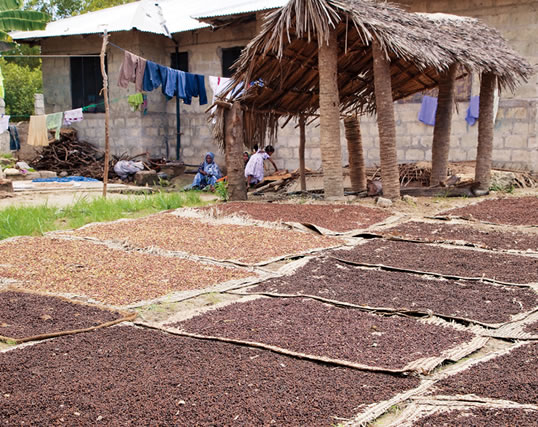 |
| Cloves are dried on mats in the sun, as they have been over more than 2000 years of cultivation, from their native habitat in the Moluccas to Indonesia, Madagascar and East Africa. They came to Zanzibar only in the early 19th century, when the Omani sultan Sa‘id bin Sultan grew the island’s production into the world’s largest. He built the palaces and complexes now known as Stone Town, including this ruined palace (below-right) intended for his wives. |
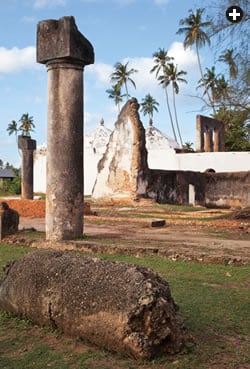 |
Something about the words cloves, Zanzibar and Stone Town piques the imagination, evoking images of a tropical paradise scented with the fragrance of its most famous export. I had been away from the island for 38 years, and arriving on a high-speed hydrofoil from Dar es Salaam on the African coast was a far cry from crossing on the dhows that, in the 1960’s, had provided the primary link to the mainland for local travelers. But the hydrofoil, loaded with mostly European tourists, symbolized the welcoming atmosphere Zanzibar authorities now cultivate in their efforts to attract visitors to their historically fascinating, multicultural island.
September, October and November, before the “short” seasonal rains begin, are the prime months for harvesting cloves in Zanzibar. I arrived the last week in October, so I expected to find the island’s roadsides lined with mats covered with cloves, drying in the tropical sun. Surprisingly, cloves were hard to find!
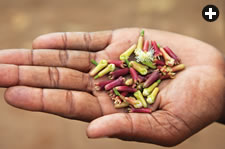 |
| Sweetly pungent, the dried flower buds of Syzygium aromaticum were once valued as breath fresheners, but more often as a food spice. Today, a large percentage of world production is burned in kretek cigarettes. Cloves continue to be harvested by hand. |
I soon learned that clove production on Zanzibar and its sister island Pemba, to the north, has declined considerably from earlier days. Since the 1964 revolution that overthrew Zanzibar’s Arab sultan, the Zanzibar State Trading Corporation has maintained a monopoly on buying and exporting cloves. As a result, farmers receive only about half what they could get if they sold to private buyers on the mainland, removing the principal incentive to increase production. Zanzibar—now a semiautonomous part of Tanzania—and Pemba once led the world in clove production; today they supply eight percent of the world’s total, a distant third behind Indonesia and Madagascar.
When I visited the government warehouse where farmers are supposed to sell their cloves, I found only two bags totaling less than a hundred kilograms (220 lbs). Nearby, three employees sat on the floor picking twigs and pieces of leaves from perhaps five kilos (11 lbs) of cloves recently arrived. Zanzibar is now clearly much more focused on cultivating tourism than cloves; nevertheless, the island’s history is inextricably linked with the clove trade.
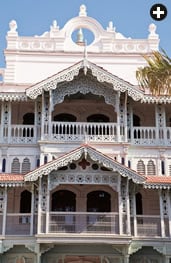 |
 |
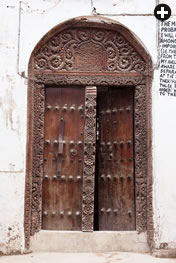 |
| European, Arab and South Asian designs blended to form Zanzibar’s distinctive architecture. Above, from left: The recently restored 1890’s Old Dispensary was built by an Indian merchant. Inscriptions in the 18th-century reconstruction of the 12th-century mosque in Kizimkazi attribute its founding to Persian traders. The mosque’s door is styled like others from the Arabian Peninsula to India, inscribed in Arabic |
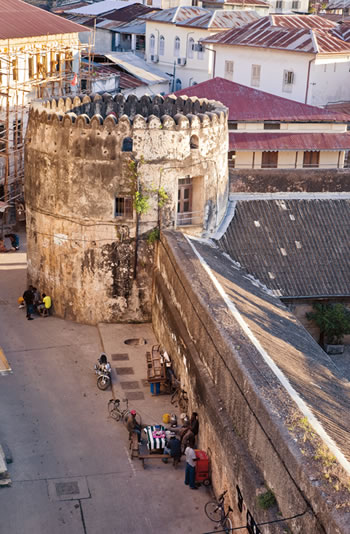 |
| After Oman defeated the Portuguese at Mombasa in 1698, they consolidated their power on the African coast with this fort in Zanzibar. |
When cloves came to Zanzibar from Madagascar in the early 19th century, they had already been a popular spice in Europe, northern Africa and Asia for centuries. The Chinese used cloves as a deodorant and a breath sweetener 2500 years ago, obtaining their supply from the Moluccas, the Indonesian archipelago where the tree originated. By the fourth century ce, cloves had been carried to the Mediterranean by Indian and Arab traders. By the 13th century, Venetian merchants, relying on provisions from Alexandria, Egypt, were the main suppliers of cloves to Europe. Eventually other European powers, especially the Portuguese and the Dutch, began to search for sea routes leading directly to cloves and other lucrative spices.
The Portuguese arrived first. When Vasco da Gama anchored off northern Mozambique in 1498, he found Arabic widely spoken and saw that he was among Muslims. Many Muslims, traders from India and the Arabian Peninsula, lived among the local people. Africa provided gold, ivory, ambergris (used as a perfume fixative), gum copal (a resin used to make varnishes), mangrove poles (used for roof construction in the traditional houses of the Arabian Gulf) and, as centuries progressed, slaves, in exchange for cotton cloth, copper, dates, pottery and other commodities.
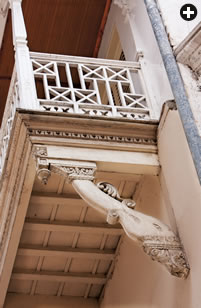 |
| Decoration on a balcony of the Old Dispensary shows South Asian influence. |
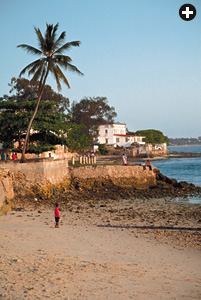 |
| A late afternoon walker on the beach
at Shangani Point, on the westernmost tip of
the island. |
 Islam had arrived in the region in the eighth century, brought by traders riding the seasonal monsoon winds south from the Arabian Peninsula. By the 10th century, Persians and Arabs were residing in many coastal settlements, providing the East African terminus of trading networks along the Indian Ocean littoral. Notably, Zanzibar’s indigenous inhabitants refer to themselves as “Shirazis,” claiming a historical link with traders from that Persian city. A mosque in the village of Kizimkazi has a mihrab, or prayer niche, with a kufic inscription dated ah 500 (1107 ce), which attributes the construction of the mosque to Persian settlers. Today’s mosque is an 18th-century reconstruction, but it incorporates the original mihrab, considered to be the oldest example of Islamic architecture along the East African coast.
Islam had arrived in the region in the eighth century, brought by traders riding the seasonal monsoon winds south from the Arabian Peninsula. By the 10th century, Persians and Arabs were residing in many coastal settlements, providing the East African terminus of trading networks along the Indian Ocean littoral. Notably, Zanzibar’s indigenous inhabitants refer to themselves as “Shirazis,” claiming a historical link with traders from that Persian city. A mosque in the village of Kizimkazi has a mihrab, or prayer niche, with a kufic inscription dated ah 500 (1107 ce), which attributes the construction of the mosque to Persian settlers. Today’s mosque is an 18th-century reconstruction, but it incorporates the original mihrab, considered to be the oldest example of Islamic architecture along the East African coast.
Trade inevitably generated cultural exchange. Since few traders brought their wives with them, many married local women. The Muslim community grew; so did a process of linguistic adaptation that eventually resulted in the language known as Swahili. In fact, Swahili—a word derived from the Arabic term for “coast”—reflects the augmentation of the local Bantu language with a rich infusion of Arabic.
Perhaps a third of the Swahili vocabulary today can easily be traced to Arabic, although the language has maintained its African Bantu grammatical structure. Swahili was written in Arabic script for hundreds of years, until European colonial and missionary schools introduced the Latin alphabet in the 19th century. (Still, I remember seeing Swahili words in Arabic script on public signs in Zanzibar’s main market as late as 1970.) Although 10 percent of the population of Zanzibar and Pemba may consider themselves Arab, few now speak Arabic, the transition to Swahili being almost complete.
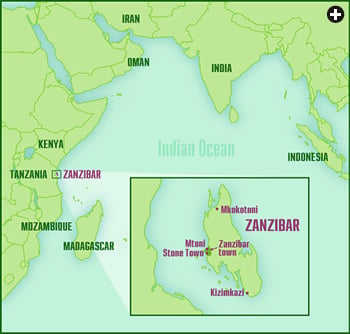 |
Swahili also incorporated Portuguese words (for fort, flag, table, auction, hammock and many card-playing terms, for example). Nevertheless, despite their presence in the Indian Ocean for almost 300 years, the Portuguese had little long-term impact on East Africa north of Mozambique. They introduced maize, cassava and pineapples (bringing them from settlements in Brazil), but taught no improved agricultural techniques. Their desire to spread Christianity had little lasting effect. This is not surprising considering that north of Mozambique their only important settlements were at Mombasa and Zanzibar. It is doubtful that the Portuguese settlement in Zanzibar exceeded 20 families at any one time, although a papal bull in 1612 refers to a priest on the island.
One curious example of possible cultural transmission is that bullfighting is still practiced on Pemba today, where some Portuguese were known to live in the late 1500’s. Not all authorities accept this custom as having a Portuguese origin, but it is curious that in the Pemba fights, as in Portugal, the bull is not killed.
Of all the Indian Ocean trading states, only the Sultanate of Oman had the power to challenge the Portuguese in the region. Omanis, like other Arabs from the Arabian Gulf, had been trading with East Africa for centuries, but Oman was larger, and had greater ambitions, than the other Gulf states, according to Dr. Abdul Sheriff, an internationally known Zanzibari historian of East Africa and the author of Dhow Cultures of the Indian Ocean.
When Fort Jesus, Portugal’s primary base in Mombasa, fell to Oman in 1698, the Portuguese gave up their dominant position in Indian Ocean commerce. Shortly after capturing Fort Jesus, the Omanis gained control of Zanzibar, ending the nearly two-century Portuguese presence there. To consolidate their position, they quickly built a fort on the island’s western tip, finishing it in 1701. From that time on, Oman was an Indian Ocean power to be reckoned with.
Omani interest in East Africa assumed a new dimension with the Busaidi family’s accession to power in Oman in 1749, and it increased substantially during the 50-year reign of Sultan Sa'id bin Sultan, which began in 1806. After consolidating his position in Oman, Sa'id turned his interest toward East Africa. He paid his first visit to Zanzibar in 1828, and with each successive trip his stay on the island lengthened.
 |
| Blending Arab and western instruments with Swahili lyrics, the taraab musicians of Zanzibar’s Cultural Music Club keep tradition alive. |
Dr. Sheriff succinctly summed up Sa'id bin Sultan’s interest in the area. “Kuwait and the other states of the Gulf came only as traders,” he said. “They were rather small city-states, rather weak, with no ambition to develop states as such. Oman was different. It was a kingdom, with a large hinterland. Sa'id would not have come only for good weather; he came for trade.”
As the head of a state whose fortunes were built on commerce, the sultan appreciated the economic potential of the clove trade. He quickly took steps to cultivate clove trees in Zanzibar, adding to the wealth already being obtained from the trade in ivory and slaves from the mainland. In fact, he ordered his subjects to plant clove trees or face confiscation of their property. By 1850, Zanzibar and Pemba were the world’s biggest clove producers. Cloves became even more important economically as Britain pressured the sultan to end the slave trade and slavery itself throughout the 19th century.
 |
| A government official wears both a traditional robe (kanzu) and a western sport coat. |
The sultan’s presence on Zanzibar led to the growth of a permanent settlement, now called Stone Town. It spread over the westernmost point of the island, adjacent to the fort. Most of Stone Town’s buildings today date from the 19th century, as do the ruins of several former royal palaces on the island and several baths built for the sultan’s wives or for the public.
When Sultan Sa'id died in 1856, his two sons split the empire between them, Majid taking the East African dominions and Thuwaini taking Oman. Although Majid got the better deal in the 19th century, the discovery of oil in Oman in the 20th century has caused the pendulum of prosperity to swing in favor of Thuwaini’s descendants. It was Majid’s unlucky descendant Jamshid who was overthrown by Zanzibar’s African majority in 1964. That happened just a month after England ended its 74-year protectorate over the island and restored to the Busaidis the control they had enjoyed before the British arrived.
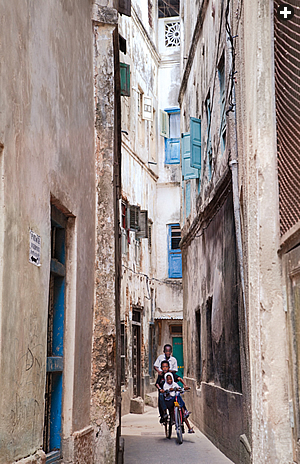 |
| In Stone Town, children ride through a narrow street. |
Though many Arabs—who had been about 20 percent of the population—left after the revolution, the island remains well over 90 percent Muslim. Christians, Hindus and Parsees are free to practice their religions, as has always been the case. Such tolerance was characteristic of the Indian Ocean littoral, said Dr. Sheriff. Prior to the coming of the Portuguese, the Indian Ocean “was dominated by the logic of trade,” he explained. “What do traders want? They want to sell their goods…. So the buyers and the sellers had no interest in practicing intolerance, or cultural intolerance. In fact, quite the opposite. They needed to encourage all sorts of people to come and trade, … whether they are Chinese, Jews, Hindus, Christians, or anybody.”
Sultan Sa'id and his successors practiced and encouraged this traditional tolerance. The multicultural character of Zanzibar is readily apparent today in the island’s music, religious practices, food, dress and architecture.
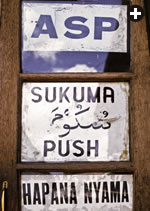 |
 |
| The language of Zanzibar is Swahili, which formed from the infusion of Arabic into the local Bantu language. |
A fusion of Arab, Indian and African musical traditions has produced a style of music called taarab. Originating as court music played in the palace of the sultan, taarab is carried on today primarily by two groups, the Nadi Ikhwan Safaa and the
Culture Musical Club, which has toured
in Europe, the us and Arab countries. Taarab music incorporates the 'ud, qanun, violin, cello and bass, as well as the accordion and a variety of percussion instruments, backing up Swahili lyrics that are often about love, longing and courtship rivalries. Visitors are welcome to attend nightly rehearsals, and performances can be found in several of Stone Town’s hotels or restaurants.
Calls to prayer from the minarets, Hindu temple bells, and Catholic and Anglican church bells are all are part of Stone Town’s daily soundscape. Ibadhi, Sunni, Bokhara and Ithnasheri Shia Muslims maintain their separate mosques. There is a small Parsee community. Some cultural ties remain with the Arab world, but political leaders no longer seek to participate in Arab councils or look to the Arab world for political support and validation. Evidence of the island’s political integration into mainland Africa is best demonstrated by the fact that a Zanzibari, Ali Hassan Mwinyi, was elected president of Tanzania in 1985 and served for 10 years.
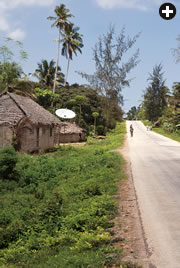 |
| A rural house, lower, sprouts a 21st-century satellite dish. |
Restaurants offer curries and other dishes of South Asian inspiration, but I also found ugali, a cornmeal paste common on the mainland. (Rice is the preferred Zanzibari staple.) Openness to foreign culinary traditions has long been characteristic of the island. In her autobiography, Memoirs of an Arabian Princess From Zanzibar, Princess Salme bint Sa'id, a daughter of the sultan, writing in the mid-19th century, said “… at Bet il Mtoni … the meals were cooked in the Arab as well as in the Persian and Turkish manner.” The tourist influx of the last 10 to 15 years has led to new creations, such as “Zanzibari pizza,” a mixture of egg and chopped vegetables wrapped in pastry, offered by vendors each evening in the town’s Forodhani Gardens in a bustling scene reminiscent of a late afternoon in Marrakesh’s Djemaa el-Fna.
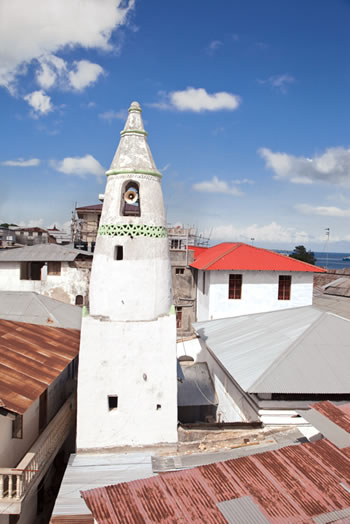 |
| In town, right, a conical minaret has a loudspeaker set into the window built for the muezzin, or caller to prayer. |
Examples of South Asian architectural influence can be seen by walking the streets of Stone Town, notably the Old Dispensary, originally built in the 1890’s as a private residence by an Ismaili Indian merchant. Following the revolution of 1964, Zanzibar’s unique architectural treasures began to crumble as the implementation of strict socialism halted investment, impoverished the economy and led to the departure of educated and entrepreneurial Zanzibaris. In the early 1990’s, however, the government began to allow private investment initiatives, and a more open political atmosphere prevailed. Unesco provided a major boost in 2000 when it placed Stone Town on its list of World Heritage Sites as “an outstanding material manifestation of cultural fusion and harmonization” of African, Arab and Indian architectural and cultural traditions.
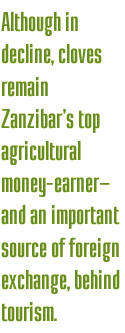 Thanks to unesco and to several major projects funded by the Aga Khan Charitable Trust, a number of important structures, including the Old Dispensary, have been restored, and Zanzibar’s architectural heritage is being preserved. Far more tourists come today to see the narrow alleyways of Stone Town than to inspect the clove plantations. Indeed, nearly 150,000 tourists visited the island in 2007, the record number to date.
Thanks to unesco and to several major projects funded by the Aga Khan Charitable Trust, a number of important structures, including the Old Dispensary, have been restored, and Zanzibar’s architectural heritage is being preserved. Far more tourists come today to see the narrow alleyways of Stone Town than to inspect the clove plantations. Indeed, nearly 150,000 tourists visited the island in 2007, the record number to date.
Most come to enjoy Zanzibar’s beautiful white-sand beaches and to snorkel and scuba dive. Massive foreign investment has fueled the construction of many resort hotels, some luxurious, some modest. Some Stone Town structures are being restored as boutique hotels. Income from tourism seems likely to encourage further preservation of Zanzibar’s heritage in stone.
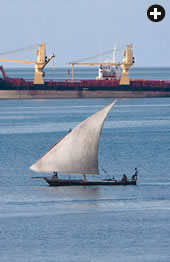 |
| Today, Zanzibar’s maritime traffic includes both freighters bearing imported goods and the traditional lateen-sailed boats, which often belong to fishermen. |
Although obviously in decline, cloves are still the top agricultural money-earner in Zanzibar and remain an important source of foreign exchange, behind tourism. Zanzibar’s new, more liberal economic policy may yet revive the industry. Replying to a question from a member of the island’s House of Representatives in June 2010, the deputy minister of agriculture said the government was distributing free clove seedlings to farmers in a bid to boost production.
Meanwhile, Seif Sharif Hamad, leader of the main opposition party in presidential elections last October, called for privatizing the clove industry. Although Hamad now holds the post of Zanzibar’s first vice president, such changes are unlikely to happen overnight. However, if farmers are allowed to profit from full participation in the global market, the image of Zanzibar as the island of cloves and stone will be not a memory, but once again a foundation upon which today’s multicultural society can thrive.
 |
Charles O. Cecil served at the us Consulate in Zanzibar from 1969 to 1971, and retired from the Foreign Service in 2001 after 35 years in order to devote himself to photography and writing, with a focus on Islamic culture. He lives in Alexandria, Virginia, and can be reached at chuck@cecilimages.com. |